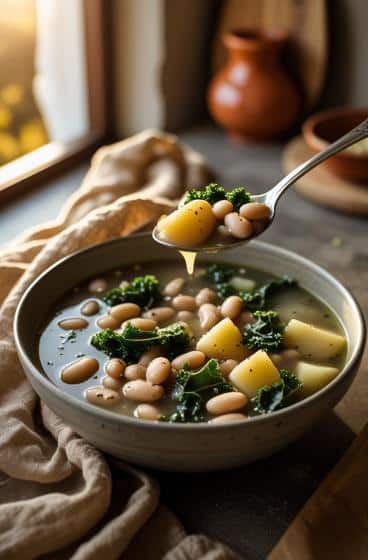Ever stood at the stove on a grey Tuscan dawn, ladling out bubbling soup as olive oil dances in the steam? Funny thing, soup. It’s simple, yet never really simple. This particular soup, the Hearty Tuscan White Bean Soup, wraps old-world peasant wisdom into every spoonful.
It’s more than a recipe—it’s a warm story about resourcefulness, generosity, and the art of coaxing depth from humble beans. Some call it ribollita if you go the bread-thickened way, or just a rustic bean soup if you skip the bread. Either way, this one’s special ’cause it marries frugal ingredients with slow-cooked patience, building layers of flavour so quietly, so stubbornly, you almost don’t notice till your kitchen smells like Florence itself.
Why This Soup Matters
At first glance, it’s just beans and greens. But look closer, and you’ll see: there’s the interplay of creamy cannellini and earthy cavolo nero, the slow alchemy of soffritto softening in good olive oil, the magic of stale bread turning broth into velvet.
A Tuscan grandmother might tell you it tastes better the second day. She’d be right, by the way. The starches meld, the flavours deepen, and leftovers outshine the first bowl. And it’s all about respect—for each ingredient, for time, and for the cook who lets the soup become itself.
Ingredients & Substitutions
Here’s what you’ll need, why it matters, and what you can do if your pantry’s missing a Tuscan market.
| Ingredient | Why It Matters | Substitutions / Notes |
|---|---|---|
| Dried cannellini beans | Creamy, hold shape better than canned | Canned beans for speed; great northern beans if no cannellini |
| Cavolo nero (Tuscan kale) | Earthy, mineral richness | Curly kale, Swiss chard, or even baby spinach |
| Stale country bread | Thickens, adds body & rustic texture | Day-old sourdough, ciabatta, or omit for a lighter soup |
| Carrots, celery, onion (soffritto) | Classic Italian aromatic base | Leeks instead of onion for milder sweetness |
| Garlic | Sharpness and depth | More or less, to taste |
| Tomato paste | Subtle acidity and umami | Crushed tomatoes or a splash of passata |
| Good extra virgin olive oil | Peppery richness & finish | Light olive oil if you must, but quality counts here |
| Fresh rosemary & thyme | Herbal brightness | Dried herbs if fresh unavailable; use less |
| Vegetable or chicken stock | Backbone of flavour | Water, if you’re really in a Tuscan farmhouse mood |
| Salt & black pepper | Balance and lift | Sea salt preferred |
A note from old kitchens: if you’ve only ever used canned beans, try dried just once. Soak ’em overnight, simmer till tender—they’ll reward your patience with creamier soup that’s never mushy.
Step-by-Step Instructions
1. Soak & Simmer the Beans
Rinse dried cannellini beans, pick out pebbles (yes, sometimes they’re there), then soak overnight. Drain. Cover with fresh water, bring gently to boil, add a sprig of rosemary, and simmer till just tender. Salt only at the end, or they’ll toughen.
If you must use canned, rinse well to wash off the tinny taste.
2. Build the Soffritto
In a heavy pot (enameled cast iron does wonders), warm generous olive oil over medium heat. Add finely diced onion, carrot, and celery. Cook slow—like, really slow. Don’t rush; they should soften and turn golden, not brown.
Burnt soffritto? Start over. It’s the soul of the soup.
3. Layer Flavour
Stir in minced garlic till fragrant, then a spoon of tomato paste. Let it darken a bit—it’ll bring sweetness and depth. Add the cooked beans (or canned), pour in stock till generously covered, and toss in a bouquet of thyme and rosemary tied with kitchen twine.
Bring to a low simmer.
4. Add Greens & Bread
Strip cavolo nero leaves from stems, chop roughly, and add to the pot. Simmer till they surrender their bitterness and deepen in colour.
If you’re going ribollita-style, throw in torn pieces of stale bread now. They’ll dissolve partly, thickening the soup into a hearty, stew-like bowl.
5. Taste, Adjust & Finish
Salt, pepper, maybe a drizzle more oil. Some like a splash of good vinegar or squeeze of lemon at the end to brighten everything up.
Tip: next day, reheat gently. Don’t boil; just coax it back to temperature. It’ll taste even better.
Common Mistakes & Fixes
- Rushing the soffritto: raw onion taste ruins everything. Take your time.
- Adding salt too early to beans: keeps them tough.
- Boiling after adding greens: makes kale bitter.
Want it spicy? Add a pinch of chili flakes with garlic. Prefer silky smooth? Purée half, keep half chunky.
Cooking Techniques & Science
Ever wondered why dried beans taste richer? It’s the slow hydration, allowing starches to cook evenly without bursting. Soaking also leaches out oligosaccharides that cause, well, social discomfort.
And that soffritto: sweating, not browning, releases sweet sugars from onions and carrots while keeping the flavour gentle.
Bread? It thickens by releasing starch, turning broth into something closer to velvet. Cavolo nero’s slightly waxy leaves hold texture even after long cooking, unlike spinach which wilts away.
A dash of acid at the end lifts heavy flavours—an old trick Tuscan cooks rarely name but always do.
How to Store & Reheat
Cool fully, store in fridge up to 4 days. Freezes well, though bread-thickened versions get mushier. Reheat gently, add fresh greens if you like, and swirl in new olive oil for brightness.
Variations & Substitutions
- Vegan: Use vegetable stock, skip cheese garnish.
- Gluten-free: Omit bread; add diced potatoes or purée some beans.
- Spicy: Chili flakes, or a swirl of Calabrian chili paste.
Tools
A heavy-bottomed pot keeps even heat. Sharp knife makes quick work of soffritto. A ladle with a lip helps serve without drips.
Serving & Pairing Suggestions
Serve steaming, drizzle golden olive oil till it shimmers, crack fresh pepper on top. Grate Parmesan or Pecorino Romano if you fancy.
Perfect next to crusty bread, grilled bruschetta rubbed with garlic, or a sharp arugula salad. Drink? Chianti, of course—or just plain sparkling water with lemon.
Rustic soup loves rustic tableware: old ceramic bowls, thick spoons, linen napkins.
Best Time to Serve or Eat
Late afternoon on a chilly day, after coming home with wet shoes. Lunch in winter sunshine with friends. Or midnight, straight from the pot by the stove when no one’s looking.
Truth? There’s no bad time.
Conclusion: Why You’ll Come Back to This Pot
You’ll remember how your kitchen smelled as soffritto melted into oil. How beans broke softly under your spoon. How a splash of vinegar right before serving made everything wake up.
This soup teaches patience pays off. That humble ingredients, treated kindly, can taste of memory and comfort. And tomorrow’s leftovers will be even better.
If you burn the garlic, start again. If it’s too thick, add stock. Too thin? More bread or mash some beans. Cooking’s forgiving if you listen to what the pot tells you.
FAQs
Can I make it ahead?
Yes, actually it’s better. Flavours deepen overnight.
What if I only have canned beans?
No shame at all—just rinse thoroughly, cook gently so they don’t break apart.
Can kids eat this?
Sure. Skip chili, chop greens smaller. Most love the creamy texture.
Do I need cavolo nero?
Tradition says yes, but curly kale, chard, or even spinach work.
Why add vinegar or lemon at the end?
Acid lifts richness, keeps soup tasting fresh rather than heavy.
If you’d like, I can also draft a printable recipe card, food styling tips, or create Pinterest-ready image prompts to match this article. Just let me know!

